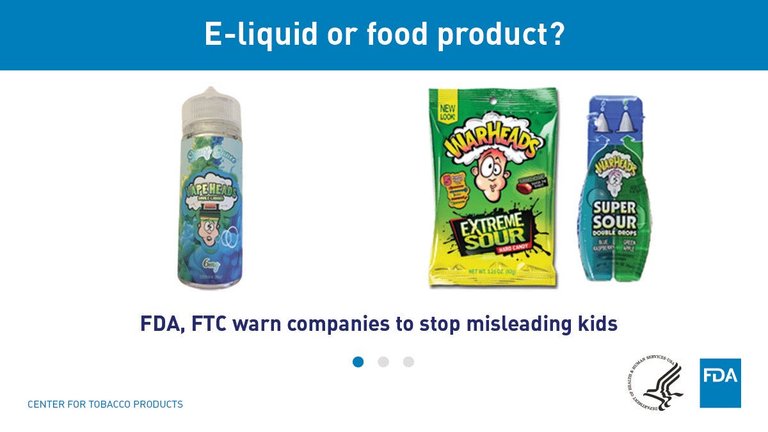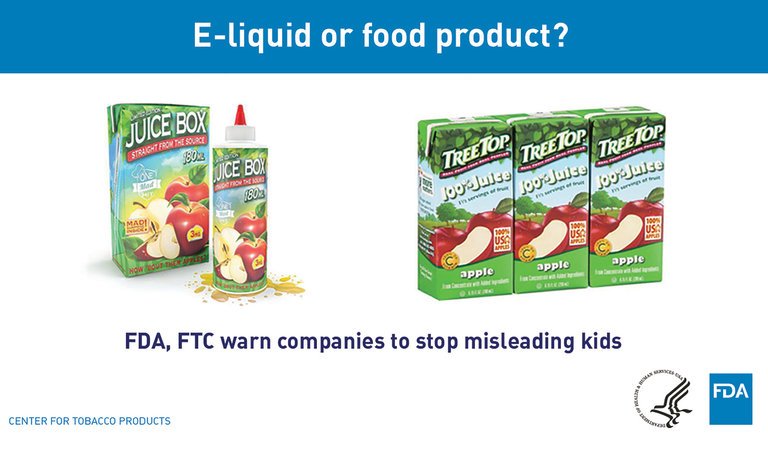Yesterday, the US Food and Drug Administration (FDA) and the Federal Trade Commission (FTC) issued a press release along with 13 warning letters to manufacturers, distributors, and retailers for selling e-liquids used in e-cigarettes with labeling that is misleading to children and resemble children's juice boxes, candies and cookies. To make matters even worse, several of the companies were also cited for illegally selling these products to minors.
No tobacco products should be marketed in a way that endangers kids – especially by using imagery that misleads them into thinking the products are things they’d eat or drink.
In the report, the FDA released a series of images that demonstrate just how similar these products are in appearance to many well-known candy and fruit juices, which are marketed towards children.



After taking one glance at these pictures, it's easy to see how a child could mistake these e-cigarette products for the respectively similar candy or food product. I mean the packaging looks almost identical. For some of them I even had to look at it twice to be able to differentiate between the two products.
This comes just after the American Academy of Pediatrics released a study last month, in April 2018, titled E-Cigarette and Liquid Nicotine Exposures Among Young Children. This study investigated the characteristics and trends of liquid nicotine exposures in young children (less than 6 years old) and compared the incidence of exposures to before and after adoption of legislation requiring child-resistant liquid nicotine packaging.
The study showed that between January 1, 2012, to April 30, 2017, there were 8,269 liquid nicotine exposures among children less than 6 years old reported to United States Poison Control Centers. The median age of exposure was just 2 years old, while children less than 3 years old accounted for the majority of exposures [83.9% (n = 6940)].
One alarming statistic this study did highlight though was that the annual nicotine exposure rate per 100,000 children increased by 1,398.2% from 0.7 in 2012 to 10.4 in 2015. Interestingly enough, after federal child-resistant packaging laws went into effect, there was a significant decrease in the number of exposures, averaging 4.4 fewer exposures per state after implementation of the law.
While pediatric exposures to liquid nicotine have decreased since January 2015, which may, in part, be attributable to laws requiring child-resistant packaging. I think this study does a great job at highlighting the effectiveness that legislation can have on protecting pediatric patients from the harms of pediatric exposures to liquid nicotine products.
I believe taking this legislation further to prevent e-cigarette companies from marketing their products to children and disguising them amongst other commonly recognized candies and food products will significantly help to reduce the incidence even further among accidental pediatric exposures.
Sources:

I would highly disagree that packaging and legislation have reduced the exposure to children. I'm not very confident in the sample size or procedure in making this assessment.
Of course, I think it is distasteful to market using children's juice boxes to promote e-cigs and I'm stunned that ANY company would choose this route as well as the marketing teams that might even suggest it.
Good post and information. Thanks for sharing. I found you on Kryptonia and hope to see more of you there. All the best.
Thank you and I agree that the marketing tactics are very distasteful but I thought the study was very well done. The sample size was n=8,269 and was a restrospective analysis of all past exposures in children. So if anything the results are biased towards under reporting. Now I agree that more factors could be influencing the result other than just packaging regulations but I do believe they have helped to reduce the incidence of exposures in children.
I think more legislation in terms of the appearance of the packing specifically the similarities to many common candy and food products would only help to further reduce the overall accidental exposure incidence in children. Do you not agree? Anyways, thank you for the thoughtful comment! :)
Since you are quite versed in these areas, do you know what would happen if a young child drank one of those little nicotine e-juice bottles?
When I was a kid I would eat the paint off the back of pencils, chew glue as if it was chewing gum, I probably did consume a whole bunch of crayons and other non food items.
I remember my friend found a cool "canteen" looking bottle under the sink at his parents house, and he wanted to play "desert ninjas" after watching some cartoon on TV, he drank from that bottle and lost his consciousness and almost died...
Kids do stupid things... =/
Companies should make sure they are not exposing their products to children. Thanks for the meaningful post.
I agree I don’t think they should be aloud to market their products in this way to children! Thanks for the comment and stopping by :)
Its crazy how similar those products look to one another! :0
Your Post Has Been Featured on @Resteemable!
Feature any Steemit post using resteemit.com!
How It Works:
1. Take Any Steemit URL
2. Erase
https://3. Type
reGet Featured Instantly & Featured Posts are voted every 2.4hrs
Join the Curation Team Here | Vote Resteemable for Witness